As cruisers along the ICW, we typically have three possibilities for “spending the night.” In descending order of cost, we can 1) take a slip in a marina, averaging $1-$3 per foot, per night (Belle Bateau is 50’ overall, so that’s $50-$150/night), 2) pick up a mooring ball, for $20-$30/night on average, or 3) anchor, for free. Once in a blue moon, we can find a free courtesy dock, but those haven’t been too frequent in the ever popular and warmer south. However, we did find one of those in Florida on Day 52 at the Jim King Courtesy Dock, north of St. Augustine.
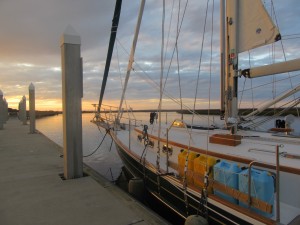
In two previous blog posts, Days 33-35, the merits of Option 1 and Option 3 were presented in detail. But I haven’t reviewed Option 2 in similar detail—until now. To me, being on a mooring ball is an experience that exists somewhere between the conveniences of a marina and the wilderness of an anchorage. For landlubbers, think of mooring fields as being in the suburbs, where you are close enough to visit the city (the marina) for urban living with cultural and practical amenities, yet not quite in the remote hinterlands (anchorages).
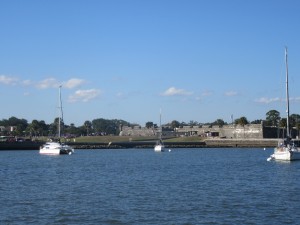
Mooring fields are identified by a well-spaced collection of 30” diameter balls that float on the surface but are permanently anchored to the seabed. A length of line called a pennant is attached to each mooring ball, usually with a loop at the end. This loop is “picked up” with a boat hook and attached to a boat using a line or bridle from the boat’s bow. Mooring balls, provided by cities or marinas, offer a secure option for staying put in heavy winds or current, and therefore insure a good night’s sleep that we don’t always have at anchor (see blog post Day 33).
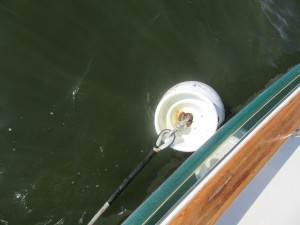
Not all marinas or cities offer mooring fields, so we can’t always choose Option 2. But when we can, we do. Mooring balls are fairly inexpensive because that’s the only amenity they provide. There is no electricity or water provided. And there is no help provided by dockhands in snagging the ball’s pennant. Nope, that’s totally my job, and I’m getting better at it. It would help if there was some standardized size or shape of pennant loops however. I never know what kind of slimy pennant my boat hook is about to grab. I’ve learned not to wear my favorite shirts or jackets during mooring ball pick-up because surely they’ll be splattered with mud. And recently, I’ve begun to wear waterproof gloves because when I wrestle the pennant to the forward cleat, it helps to have a firm grip and clean hands afterwards.
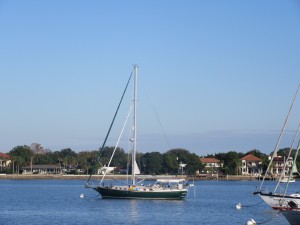
We like mooring balls, but living in these sea suburbs means that we can’t get to shore without using our dinghy. Same thing with living in the hinterlands when anchored. But taking a dinghy to shore should be simple enough, right?
Hmmm. It depends. In nice weather, perhaps it’s not too bad. But consider these steps. First, we check the air in the pontoons, and fill any of the three chambers if required. Then we load the Coast Guard required equipment (life preservers, horn, lights, etc.) into the dinghy. Then we towel-dry the dew-soaked or rain-drenched seats and load anything we want to take with us to shore, being careful to keep certain things dry, either from the wet dinghy floor or the spray that may enter the boat on the short ride.
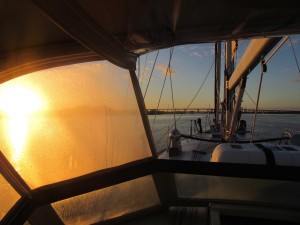
We check to be sure we have everything—inevitably we forget something. Then we gingerly step inside the dinghy and get seated. I insist on sitting on a towel each and every time because there is always something on that seat or pontoon, be it bird poop, grease or rain. I really hate to learn at the end of the evening that I walked around all day with a big brown spot on the back of my white pants. Yes, it’s happened.
And then, we are ready. It’s time to start the blessed *%#*#^* engine.
Let me just say right now that I ABSOLUTELY HATE any motor that must be started by ripping one’s arm out of its socket or tearing up a perfectly good shoulder. This applies to lawn mowers (just ask my dad how much I enjoyed cutting grass as a kid) and dinghy outboards. I don’t consider myself a weakling. After all, I’m a 4-time triathlete. And still, that outboard engine gives me a fit.
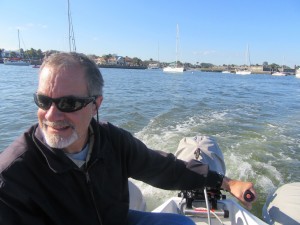
Truth be told, Dudley doesn’t always have the easiest time with starting it either. But if he can start that engine with three pulls, then I should be able to as well. This is especially important because I want to be independent! That dinghy represents trips to shore alone, not just when both of us need to go. It’s like living in the suburbs and relying on someone else to take you to the grocery store or the city or the park. That ain’t fun!
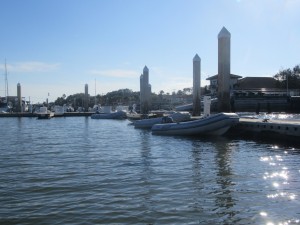
It won’t surprise you to know that I have asked Santa to leave me an electric start outboard under the Christmas tree. My right shoulder is still sore from yanking and tugging and pulling a couple of days ago. Ugh! But I hear those electric start engines are heavy, not to mention expensive. It’s always something. Hope Santa can figure this out.
But outboard engines aside, living in the suburbs means that money not spent in a marina can be spent sightseeing and dining out. Yippee! So when we reserved a mooring ball in St. Augustine’s north field at the base of the fort beginning on Day 53, we were in for 4 nights of blissful sleep and 5 days of delightful excursions to the city. This city has been on our bucket list, and we were not disappointed!
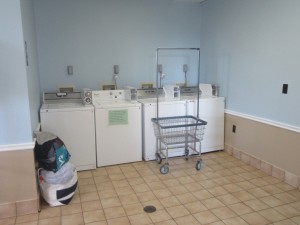
Our dinghy made many trips back and forth to the marina’s dinghy dock from mooring ball #05. Once on land, we could do practical chores, like laundry and provisioning. And we could do lots and lots of fun things, like miniature golf, shopping, walking, eating, more walking to burn calories, and more eating at St. Augustine’s amazing restaurants.
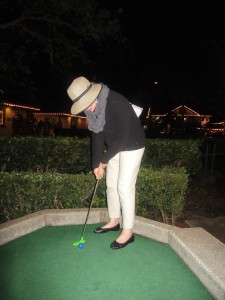

The citizens of St. Augustine boast about their Nights of Lights, and indeed they should! We enjoyed the lights while in the city as well as “back in the ‘burbs” on the boat. But the best light show occurred on Day 55. That will be it’s own blog post. Stay tuned.
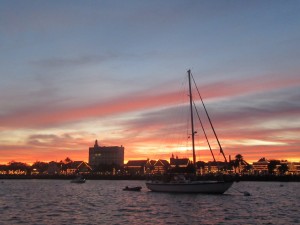

I love St. Augustine, also! And you have given me a whole new perspective on this beautiful place. I am so enjoying your blog and am in awe of what you two are doing! Thanks for sharing!
Thanks for following the blog! More photos from St. Augustine in next blog post, hopefully later today. So stay tuned.
We also enjoyed St. Augustine at Christmas time. Larry wondered if you are familiar with the Alligator Farm that is a few blocks from the fort. There are walking bridges through lagoons with birds. They come there in April to nest and have their babies, a photographer’s dream. There may be birds there this time of year also. Look forward to reading your blog every day and enjoy all our lovely pictures.
Thanks Charlotte and Larry. We did hear about the Alligator Farm but didn’t make it there before we had to head further south. So it’s on our list to visit in the spring when we head north. We also didn’t get to tour Flagler College, so that’s on the list too. What a great city! And thanks for following the blog. I’m a bit behind but today is a bit rainy so I have a good excuse to stay inside and write!